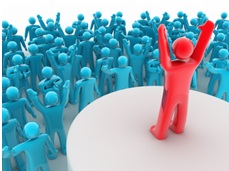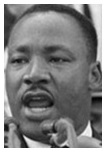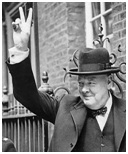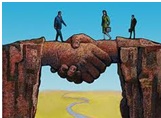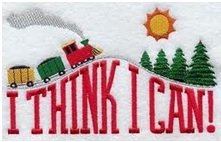|
 |
|
 |
|
|
||
Leadership
Leadership is... Inspiring people to do great things. (e.g. satisfy customers better than competitors).
How to be a great leader
1. Have a vision (a future ideal for everyone to work for) This vision should: a) inspire people to dramatically change their situation (for example, Martin Luther King’s ,pictured right, dream of racial equality in America).
b) be relevant to people’s needs (or people won’t believe in the vision). This is why Churchill’s (pictured right) vision of “victory at all costs” was so successful in Britain in 1940.
c) be centred on satisfying customers and employees.
So leaders must also think about:
2. Effectively communicate the vision Everybody must clearly understand the vision, so that they can effectively carry it out. Inspirational oratory can help (e.g. Abraham Lincoln (pictured right), Martin Luther King and Winston Churchill).
3. Inspire (or empower) people to do great things How?
A leader must make sure that everyone has the right values like customer satisfaction and lives by them.
b) be a servant leader A servant leader serves the needs of followers (or employees) by:
c) trust people (giving people autonomy and power).
d) integrity and intelligence The best leaders lead by example. They are respected and trusted for their:
Trust is hard to win and easy to lose.
e) humour A laugh can win people over.
4. Be tough and tender (or kind) This mixture is sometimes called ‘tough love’. In the Eastern religion, Taoism, toughness is the Yang of leadership and kindness the Yin. The best leaders are courageous and ruthless enough to make difficult decisions but sensitive to people’s needs.
5. Make change work Leaders should give people hope and persuade them to change, if necessary. So people shouldn’t be exploited or manipulated but empowered to change.
6. Be creative and flexible Leaders should:
7. Make the most of their ability Leaders should:
a) know themselves (to make the most of their strengths and work on their weaknesses).
b) have challenging aims (for themselves and the organization).
c) continually improve (through lifelong learning).
d) have energy, stamina and support Leaders must get enough sleep, keep fit, love their job but still have enough time for family and friends (who can give support in times of trouble).
e) be pragmatic idealists Have ideals but flexibly think of practical ways of achieving them. f) think positively
8. Keep in touch with stakeholders Business leaders must build successful long-term relationships with stakeholders, particularly customers, employees and suppliers (responding very quickly to their changing requirements).
9. Change your leadership style to suit the situation The best leaders keep their values and principles but adapt their leadership style to different situations. These different styles include:
a) autocratic (do what I say) For quick decisions.
b) assertive (this is where we are going and why) For vision and long-term objectives.
c) friendly (getting on with people) For teamwork, motivation and empowerment.
d) democratic (asking people what they want and think) For innovation, motivation and empowerment.
e) standard setting (setting performance standards) For excellence and quality.
f) coaching (showing people how to do their jobs better) For empowerment and learning.
10. Choosing future leaders Leaders must groom a successor who will carry on their work successfully.
Key quotes explained
“A leader is best when people barely know he exists...when his work is done and his aim fulfilled, they will all say ‘We did this ourselves’” - Lao Tzu (Chinese philosopher, pictured right) Great leaders are enablers i.e. they empower people and enable them to do great things. To do this, Lao Tzu says, they must be:
This is why Lao Tzu says that “To lead walk behind them” - a view identical with Nelson Mandela’s idea of ‘leadership from behind’.
“The true leader takes humanity as his burden” - Confucius ,Chinese philosopher (pictured right) Leaders should put people first and lead by example (moral leadership).Then “They will have a conscience and will reform themselves”, Confucius also says. So Confucius believes they must keep the good of the past (having a sense of history) and change what needs to be changed with a kind heart (because they should love their people). “Power based on love is a thousand times more effective than power derived from fear of punishment”, said Gandhi, the Indian leader.
“My policy is to have no policy” - Abraham Lincoln ,American president (pictured right) Like other great leaders, Lincoln was a pragmatic idealist (having ideals but never dogmatic). He was flexible and continually changed his policies to suit changing situations. Another American president, Theodore Roosevelt, similarly described successful leadership as “a combination of idealism and practical efficiency”.
“It is excellent to have a giant’s strength, but it is tyrannous to use it like a giant” - Isabella (in Shakespeare’s ,pictured right, Measure for Measure) Use power for other people’s advantage (not your own) and make decisions that people can carry out effectively. “What you cannot enforce, do not command”, the Greek playwright,
Sophocles said.
Best books
Warren Bennis (pictured right) and Burt Nanus (pictured right below), Leaders (1985) Successful leaders use their strengths to put their vision into action. They “do the right thing” (i.e. create change by challenging the status quo). Managers put the leaders' ideas into action and “do things right”. Similar conclusions were made by
(For more detail see Leaders in the Business Books section)
James MacGregor Burns (pictured right), Leadership (1978) There are two types of leadership:
Robert Greenleaf (pictured right), Servant Leadership (1977) The best leader is a servant leader who serves the needs of his (or her) people.
Niccolo Machiavelli (pictured right), The Prince (1513) The means justify the ends (today called Machiavellian) i.e. leaders can do anything (even bad things) to get what they want. The best leaders have:
It is far better for leaders to be feared than loved, if they cannot be both.
John Harvey-Jones (pictured right) , Making It Happen (1988) The ex-boss of the British chemicals company, ICI, says the best leaders:
a) are customer driven, open to new ideas and pragmatic (responding well to new situations).
b) embrace change (and challenge the status quo).
c) encourage people to be the best Through:
d) give people “headroom” (freedom to achieve their aims).
e) use “judo management” (changing negative attitudes into positive ones).
f) are catalysts (making small changes that have big effects).
g) think and then act (based on knowledge, experience and common sense).
Max De Pree (pictured right) , Leadership Is An Art (1989) His Dad (the boss of the American office furniture maker, Herman Miller) discovered that a recently deceased employee had been a great poet. This taught Max De Pree that leaders should make the most of their people’s talents.
Dale Carnegie (pictured right), How To Win Friends and Influence People (1936) (For more detail see How To Win Friends and Influence People in the Business Books section) Leaders and managers should:
Jack Welch (pictured right), Straight from the Gut (2001) (For more detail see Straight from the Gut in the Business Books section) The highly successful ex-boss of General Electric says the best leaders have the 4 E’s:
Tough love is vital i.e. kindness mixed with toughness to make difficult decisions like making redundancies and firing incompetent employees. Welch’s 20:70:10 rule says that in any group of managers 20% will be top performers, 70% average and 10% not worth keeping.
John Adair (pictured right), Effective Leadership (1983) A leader must:
So a leader’s most important word is ‘We’ and the least important is ‘I’.
Peter Senge (pictured right) , The Fifth Discipline (1990) The best leaders have three roles:
Jim Collins (pictured right) , Good to Great (2001) (For more detail see Good to Great in the Business Books section) The best leaders have:
Collins calls this “level 5” leadership which is supported by Joseph Badaracco’s Leading Quietly (2002). Badaracco concludes that the best leaders aren’t heroes but quiet, modest and tenacious.
Ronald Heifetz (pictured right) , Leadership Without Easy Answers (1994) “Adaptive leadership” is vital - mobilizing people to solve difficult problems in times of change. |
|
|
||
|
|
||
| Copyright © wisdomtowin.com 2025 All Rights Reserved | ||
|


